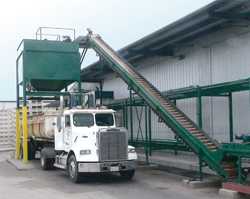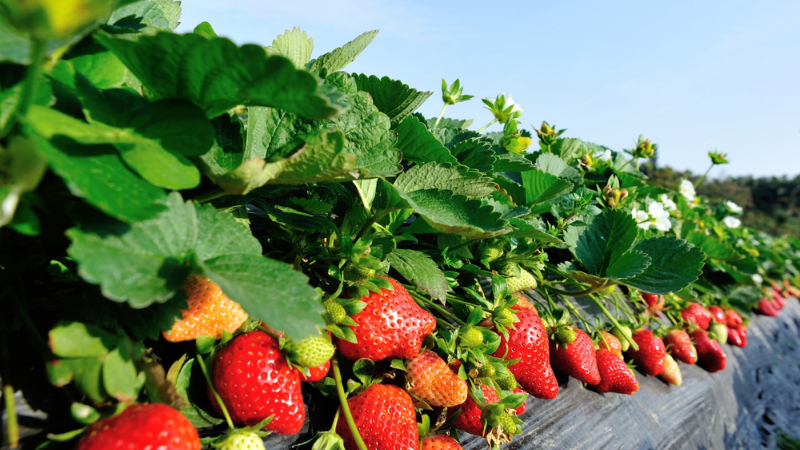Reduce Disposal Costs

According to the National Agricultural Statistics Service, U.S. growers produced approximately 24 million tons of fresh vegetables in 2007 with a value of $10.8 billion. Fresh market tomatoes accounted for more than 10% of this total, or $1.6 billion in 2006.
Florida tomato growers produce about 30% of this amount, making it the leading fresh market state. The Florida tomato packing season begins in September in the northern part of the state and progresses southward to central and southern areas as winter approaches. Following the winter season, production leaves the southern areas and returns to central and northern areas, ending by early July.
Along with this tremendous production, however, comes the increasing challenge of economical disposal of solids and water that is generated during packing operations. Anticipating further increases in these costs, Florida tomato packer/shippers brought these concerns to the Office of the Dean for Research at the University of Florida/Institute of Food and Agricultural Sciences.
A task force was formed consisting of faculty members with statewide and county responsibilities covering a wide range of disciplines. In cooperation with the Florida Tomato Committee, a survey instrument was developed to quantify these amounts and was distributed to Florida tomato packers during spring/summer 2007. Responding companies handled mostly round tomatoes, although some included data for roma, grape, and cherry tomatoes.
Results indicated the quantities of solids and water generated during a packing season, and the disposal methods used are in accordance with local and state regulations. The information provided in this article should be useful to provide baseline information for other vegetable packers to evaluate methods and technologies that could help reduce costs associated with packing operations.
Solids And Water Generation
Cull Tomatoes. Results from the survey indicated that packouts for the season were typical and ranged from about 60% to 80%, depending on the time of the year and weather events. Packout is defined as the percent of tomatoes that meet grade standards for shipment and varies from lot to lot.
Since accurate totals for statewide generation of tomato culls were not possible from the survey data, total culls were estimated from annual shipment data published by the Florida Tomato Committee for the 2005-2006 shipping season. Total shipments reported for that season amounted to 598,000 tons of green, pink, and field-packed tomatoes. Packout values correspond to culls, which translates to the totals in the Packout Values chart.
Other Solids. From the survey, other plant materials (leaves, etc.) from packing were mostly disposed with culls. Some companies estimated amounts from 2 to 5 tons per week. Carton/pallet waste estimates ranged from 10 to 80 tons per packing season, depending on the size of the packer.
Water. Current Best Management Practices include emptying the dump tank daily for cleaning and refilling the following day with potable water. This water is recirculated and sanitized throughout the day; additional water is used for washing and rinsing the tomatoes. Water for tomato dump tanks ranged from 3,000 to more than 20,000 gallons per day. Other water from washing/cleaning operations ranged from 50 to more than 4,000 gallons per day. The total amount of water requiring disposal for the reporting packinghouses was 31.3 million gallons for the packing season.
Current Disposal Methods
Tomato culls and plant debris were disposed on vacant land and pastures. Some were disked-in daily, others were fed to cattle. They were hauled by the companies’ own trucks or by paying another company. All carton/pallet waste was recycled and some was sold to third parties. Water disposal varied by packer and location and is shown in the Water Disposal Methods chart.
Reported season costs for cull disposal was $731,300, and dump tank and other water costs was $154,600. These costs will continue to increase as land around production areas becomes more urbanized, forcing culls to be hauled to more distant sites. Other increases include higher fuel costs for vehicles and higher electrical costs required to run packinglines and refrigerate cold rooms.
There are two potential areas that packers can consider for reducing disposal costs. The options cited below range from low to high investment and must be evaluated on an individual basis.
1. Reduce the amounts of solids and water requiring disposal.
– Cull tomatoes can be removed in the field during harvest, reducing hauling costs to the packinghouse and disposal costs after packing.
– Culls removed during packing can be macerated and screened, significantly reducing the solids volume requiring disposal. The resulting juice can be treated on-site or discharged into the municipal system.
– Dump tank water can be filtered for reuse, either continuously or when the packing line is not running. The once-used wash/rinse water could also be treated and used to fill the dump tank as make-up water.
– Water can be treated for disposal in municipal systems by several methods, including sedimentation, dechlorination, filtration; ion exchange or adsorption can remove trace elements.
2. Create alternative uses for solids.
– Culls and dewatered solids can be used for compost.
– Culls can be converted to generate electricity or heat.
– Anaerobic digestion can convert 90% of cull volume into biogas, a mixture of methane and carbon dioxide. Remaining solids can be disposed or used in compost.
– Macerated culls could be concentrated and transported to a regional ethanol facility for conversion into ethanol by fermentation.
Significant amounts of tomato culls and wash water are generated during packing operations. The values presented here represent less than 30% of those generated by U.S. tomato packers, and are but a fraction of those generated by fresh fruit and vegetable packers. The above options need to be explored on a case-by-case basis in order to reduce operating expenses.









